|
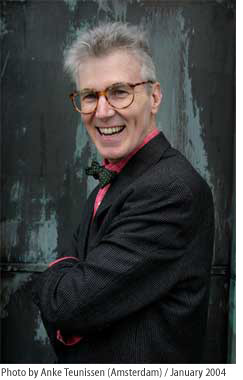 Interviewer:
Can you summarize what you were doing in your two most recent books –
the Cassavetes on Cassavetes and the book on Shadows? Interviewer:
Can you summarize what you were doing in your two most recent books –
the Cassavetes on Cassavetes and the book on Shadows?
Carney: What I was doing?
Interviewer: Why did you
write them?
Carney: For a lot of different
reasons – most of which I didn't understand until years into the process.
Consciousness is always the last to know. Only in the struggle to express
and structure something do you discover what you want to say. You can't
know what you are doing until you do it. Like talking. You learn what
you think in the process of saying it. That's the way it's been with everything
I've ever written.
Interviewer: Is that frustrating
or confusing?
Carney: No, it's actually a
pretty neat thing. It keeps a project interesting because you keep changing
your mind and understanding it differently as you go along. In fact I
tell filmmakers who write me that if the film they end up with is the
same one they thought they were going to be making when they started,
or if they feel the same way about the characters as they did when they
wrote the script, they have wasted their time.
Interviewer: Why is that?
Carney: Because they haven't
allowed themselves to learn anything. As Nick Ray said, if it's all in
the script why bother to make the movie? Publish the script. That's a
lot cheaper and quicker.
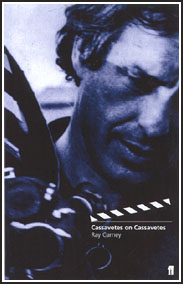 Interviewer:
Can you describe what you learned as you wrote the Cassavetes on Cassavetes
book? Interviewer:
Can you describe what you learned as you wrote the Cassavetes on Cassavetes
book?
Carney: I guess I started out
thinking it would be a much simpler study than it turned out to be – pretty
much a straightforward biography – one that focused on the events connected
with the making of the films than on the personal life. The structure
would be to alternate explanatory factual paragraphs – my words – with Cassavetes'
statements – his words. But it turned into an deep examination of Cassavetes'
soul. And even the simplest facts took heroic efforts to ferret out.
Interviewer: What do you
mean?
Carney: The amount of research
required to establish even the most basic facts was staggering. Since
I was writing the first biography, there was no previous biography to
consult; and to make things worse, the facts were hopelessly confused
in all of the standard reference books. You could find five or six conflicting
versions of even the simplest events – like the year Rowlands was born,
or when she married Cassavetes, or where Cassavetes went to college, or
the date a particular film was made or released.
As I did the basic research
I found out that all of the reference books were wrong. So I really
had to begin from square one. I realized I couldn't trust anything that
had been published. I had to check every individual fact. It took me years
to sort out the myths and work down to the realities.
Interviewer: Why were there
so many mistaken accounts?
Carney: Cassavetes and Rowlands
simply made a lot of it up. They both had a high sense of privacy, and
not a lot of respect for reporters. One of Cassavetes' bits of advice
to friends used to be: “Just remember you don't owe reporters the
truth.” So he and Rowlands would tell journalists whatever they wanted
to hear. And since all the reference books are based on newspaper reports
and press releases, they are full of errors.
You know the way these books
are written, don't you? No one actually does any research.
 Interviewer: What do you
mean? Interviewer: What do you
mean?
Carney: The way most reference
books are put together is that the editor or author of an entry simply
goes to two or three earlier reference books and re-writes what they say
and inserts it in his book. No one actually checks any of the facts.
One reference book borrows from another and a third quotes or borrows
from the second in an endless, fictional ring-a-round-the-rosy of mistakes
which are repeated in book after book. It's like a bad student paper.
“Research” consists of copying the article out of another book,
lightly rewritten to avoid charges of plagiarism. If a student did this,
he'd be thrown out of school; but when the Encyclopedia Britannica
does it, it's apparently OK.
The result is that once someone
publishes a screwed up account of something in Cassavetes' life – say,
that he majored in English at Colgate, or that he took the money he made
from his Johnny Staccato television series and went off to make
Shadows with it, or that Faces was filmed in 1968, or that
his work was improvised – then everyone else reprints it and the mistakes
assume the status of facts – since all the books say they are
true!
The American Film Institute
web site still misspells Cassavetes' name in some of its entries.
The PBS American Masters internet listing has him attending colleges
he never went to, gives wrong dates and facts about the filming of Shadows
and Faces, and misspells Gena Rowlands' name. The 2002 edition
of the Encyclopedia Britannica has Cassavetes attending the wrong
college, majoring in something he never studied, has the wrong movie for
his first film acting appearance, the wrong show for his television debut,
and the wrong date for the release of Shadows. (Click here to see the Google display of web sites, including those for The Encyclopedia Britannica, Time Magazine, Encarta, The New York Times, and PBS's American Masters television biography series that still show Cassavetes to be a Colgate graduate, even at this late date two decades after his death.)
That's a fair indication of
the reliability of the English-language reference books. The French are
worse; they make us look good. Cassavetes is kind of a cult figure there
and it's one of the curses of something being popular that since you can
sell more or less anything that is published on the subject, there is
no pressure to do good work. It's like Microsoft and software. If you're
too successful, there's no incentive to do it right. There are four or
five books about Cassavetes in French and every one of them is riddled
with hilarious errors. The worst of the lot is one by a woman named Nicole
Brenez. It is like reading science fiction – if you know anything about
Cassavetes. Among American critics, Jonathan Rosenbaum has perpetuated
many of these errors in his writing. It turns out he and Brenez are friends.
He should pick his friends more carefully – or be more careful about praising
their work.
Interviewer: It's a little
surprising to learn that you were the first person to check any of the
facts. Cassavetes has been dead twelve years.
Carney: It tells you something
about the critical neglect of his work and the shabbiness of what passes
for film scholarship – in Chicago and Paris. Research takes a lot of time
and energy. You can't just do a flyby. Rosenbaum's work is pretty shabby,
but he isn't alone. The documentary films that have been done about Cassavetes
are just as full of mistakes. They were all quickie jobs – you know, you
fly into New York or Los Angeles for five days, grab interviews with everyone
you can get, and edit the whole thing in a rush to beat some film festival
or broadcast deadline.
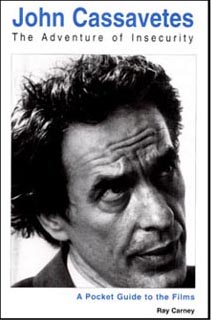 Interviewer:
How did you arrive at the truth? Interviewer:
How did you arrive at the truth?
Carney: There's no shortcut.
I went to the sources. I wrote hospitals to get birth dates. I checked
theater logs to get release dates. I scrolled through miles of microfilm
in library basements reading fifty year old newspapers. It took years – and
thousands of hours.
It was a slow process. And
a hard one. Some of the facts came from talking with people who had worked
with Cassavetes – Peter Falk or Ben Gazzara or Bo Harwood or someone else.
But people's memories are very fallible and incomplete and untrustworthy
and most of the important information had to be triangulated.
Interviewer:
Triangulated?
Carney: You know, the way the
CIA works! You piece an event together from someone's memory, combined
with a sentence in a press release, combined with a mention of something
in a newspaper article, combined with something Cassavetes himself said
that related to the issue – hours or days of research – which would, when
I put all of the information together, result in a single sentence in
a headnote.
It might take something like
a dozen hours of research to write the section of the book where I talk
about how Cassavetes' drafted three scripts of the play version of A
Woman Under the Influence in a certain month; revised them in another;
persuaded Ben Gazzara to appear in the play; went out to Wisconsin to
raise money; failed; went to New York to attempt to persuade Joe Papp
to mount it; failed again; combined the scripts into one film script;
showed the revision to Peter Falk during a meeting with Elaine May about
Mikey and Nicky, and so on. There was no one person who knew the
whole story except for Cassavetes himself and he had died by the point
that I wanted the details. So you piece it all together from the individual
parts that Ben and Peter and Gena knew. A very labor intensive method.
I watch the crawls on Nova and Frontline where the names
of the researchers are listed with a little more reverence nowadays! And
since I had no money to do any of it, my students and I did a lot of it
late at night after our classes or day jobs were over. The internet by
the way was of almost no use. Surprise. You have to take a trip to the
library. We did our research the old fashioned way.
 Interviewer: Can you talk
about the long table you showed me before we began? Interviewer: Can you talk
about the long table you showed me before we began?
Carney: Sure. I call it “the
bible.” I began by creating a massive timeline in database form with
fields for every month of Cassavetes' life. Then I and my student volunteers
went about filling it in, block by block. Since there were so many myths
in circulation, getting at the truth was a Rashomon-like process
of consulting all available sources of information and piecing together
the most likely version of what really happened, based on where the various
accounts agreed, working from the known to the unknown, one fact at a
time.
We began by filling in every
documented event that could be pinned down – like the date a certain film
was released in a particular city or the date and place Cassavetes gave
a particular interview. A lot of that was information that could be obtained
from a newspaper, radio, or television station librarian. Then I picked
the brains of people who knew Cassavetes at various times in his life
and who had lived through particular events. I read all of the published
interviews any of them had ever given; obtained tapes or transcripts of
unpublished interviews with them; and conducted hundreds of hours of additional
interviews on the phone, by email, or in person.
Since I knew most of these
people and they were enthusiastic about the project, almost all of them
were extremely helpful. Beyond sharing their recollections, a number of
them – Ted Allan, Sam Shaw, Meta Shaw, Edie Shaw, Larry Shaw, Susan Shaw,
Bo Harwood, Mike Ferris, George O'Halloran, Hugh Hurd, Lelia Goldoni,
and Mo McEndree most notably – provided treasure troves of private material:
story-boards that Cassavetes used during his editing process, layouts
for posters and ad campaigns with his comments on them, unpublished interviews,
drafts of scripts, press clippings – amazing unknown material. Sam Shaw
spent odd moments writing out his recollections and sending them to me
for more than five years.
The fact-checking went on for
years. I would learn something new from one person or source and then
check it out with everyone else who might have information about it. Meanwhile,
I assembled a clipping file based on published newspaper and magazine
accounts which I used to cross-check peoples' memories of dates and events.
I have three file cabinets bulging with clippings. The final strand of
the weave was piles of material that were sitting more or less untouched
in film archives.
I can't begin to communicate
how challenging it was to establish even basic sequences of events. Myths,
misconceptions, and press release versions of reality were everywhere.
I checked everything I possibly could six ways to Sunday, but I'm sure
a few mistakes sneaked into the book despite my best efforts to ferret
them out. That's why it took almost eleven years to do it. In the case
of the conversations I had with individuals, I worked with a degree of
urgency since I knew that they wouldn't be around forever. I was really
lucky to have had a chance to talk to some of them while they were still
around. Ted Allan, Sam Shaw, and Hugh Hurd have all died since I began
my research. Fortunately I spent hours with each of them.
Interviewer: Sounds like
a lot of work.
Carney: There is a lot of information
in the headnotes. If you took them out of the book and simply printed
them one after another, you'd have a book-length biography. I actually
did that at one point, printed out all the headnotes separately, so I
could read them as one continuous narrative. And they made a book by themselves.
In effect, I was researching and writing the first biography ever written
about Cassavetes. It's hard to quantify, but my best guess would be that
there are at least five thousand new facts and events in the headnotes
that have never appeared in print before. And that was just the headnotes.
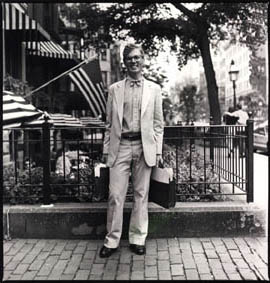 Interviewer: What do you
mean? Interviewer: What do you
mean?
Carney: Well, the Cassavetes
on Cassavetes book consists of two parallel texts – my words and
Cassavetes' words. My words were only part of it. For his words, I could
draw from my own interactions with him in the final decade of his life – letters,
phone calls, and conversations – but I wanted the book to represent
his thoughts at different stages of his career, so I contacted universities,
film archives, radio and television stations, and newspapers all over
the country – everywhere that I could imagine he had ever given an
interview or appeared at an event – to dredge up statements he had
made. Since newspapers and magazines so heavily edit anything they print,
wherever possible I located the actual audiotape or raw transcript, rather
than relying on the published transcription.
The problem
then was that I had far too much to use. Even early in the process I accumulated
more material than I could ever put in a single book. So I knew I would
have to leave a lot out. Every single paragraph quoting Cassavetes' thoughts
about a subject involved comparing five or ten different statements he
made dealing with that particular topic, and selecting the best or most
revealing answers – often by weaving together sentences from different
statements. I explain the rationale in the Introduction.
The combined text then went
through various drafts as I showed it to friends. A few years into the
process, I learned that it was such a hot commodity that it was being
pirated. Fuzzy, dog-eared Xeroxes of Xeroxes of Xeroxes were being passed
from hand to hand by young actors in New York.
Interviewer: How did you
find that out?
Carney: I think the first time
was when I was on a radio talk show to promote another book. I was out
in the hall, chatting with Louis Malle and Brooke Smith who had been on
before me. It may have been to talk about Vanya on 42nd Street.
I made some reference to Cassavetes, and Brooke told me she had this manuscript
that she kept on her night table. She told me how amazing it was and that
if I was interested in Cassavetes I should read it! Of course, I instantly
realized she was talking about one of the early drafts of my own book!
We had a good laugh over that. Her Xerox was so removed from the original
that there was no acknowledgement that I had compiled it.
There were a number of other
encounters like that over the years. When Jim McKay interviewed me for
Filmmaker magazine he told me a similar story of how he had a pirated
typescript which he read for encouragement and inspiration.
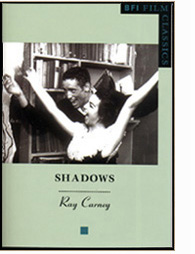 Interviewer:
Were you angry about being pirated? Interviewer:
Were you angry about being pirated?
Carney: No. I felt terrific.
Don't forget we're talking about a point at which I couldn't pay
anybody to publish the book. I would have personally presented a copy
to every actor in New York just to know that it was getting read by somebody.
There are lots of good books, going way back to Shakespeare's Sonnets
and many of his plays, that have circulated in pirated copies long before
anyone saw fit to print them.
Interviewer: So it took
you almost ten years to put the quotes together and work out all the facts,
before you were done?
Carney: Not at all. Not even
close. That was just the beginning. The really fun, really hard part remained.
Getting quotes and determining facts was only a small part of the process – and
not really the most important part. The real challenge and fun of writing
the Shadows and Cassavetes on Cassavetes books was the interpretation – deciding
which facts mattered and which didn't; what events should be included
and which should be left out; which issues or aspects of Cassavetes' experience
were related to which others; what causal links existed between different
things; and, above all, what any particular event or fact or quote meant.
Even long after most of the basic facts were established, the meanings
kept changing from day to day, almost from hour to hour.
It made me realize what it
is like to write history – real history, the real way. We get so used to
thinking that the truth is sitting out there waiting for someone to come
along and record it. We have that idea because we are used to looking
things up in a book. But that's a false conception. History – in this case,
the history of Cassavetes' life and work and what it means – isn't just
sitting somewhere waiting to be written down. It's something we create
out of a jumble of this and a mess of that. It's not found; it's made.
And that takes work. A lot of work.
Interviewer: I'm not sure
I follow. Can you say more about what you mean when you say we create
the meaning? When you say we make history? Isn't it just a matter
of establishing the facts? Even if it involves triangulating them, as
you called it before?
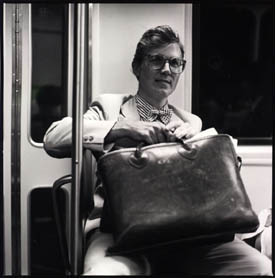 Carney: No. Not at all. The
facts are just a step. And not necessarily the first one! You know the
joke about the three umpires for the MIT baseball team? One is a Newtonian.
When batters question his strikes, he responds: “I calls 'em as they
are.” The second knows relativity and replies: “I calls 'em
as I sees 'em.” The third knows quantum mechanics and says: “They
ain't nothing until I call 'em.” Well, when it comes to facts, every
historian has to be a quantum mechanic. There are no facts. There are
only observers. Facts cannot precede an interpretation. The interpretation
creates the fact. Or as Levi-Straus put it, there are no raw data. To
be a datum is to be cooked. Carney: No. Not at all. The
facts are just a step. And not necessarily the first one! You know the
joke about the three umpires for the MIT baseball team? One is a Newtonian.
When batters question his strikes, he responds: “I calls 'em as they
are.” The second knows relativity and replies: “I calls 'em
as I sees 'em.” The third knows quantum mechanics and says: “They
ain't nothing until I call 'em.” Well, when it comes to facts, every
historian has to be a quantum mechanic. There are no facts. There are
only observers. Facts cannot precede an interpretation. The interpretation
creates the fact. Or as Levi-Straus put it, there are no raw data. To
be a datum is to be cooked.
I'm not talking about problems
with differing newspaper accounts or with reference books printing wrong
facts or with people's memories being faulty because something happened
so many years ago. I'm talking about what things mean. I'm talking
about the essential nature of any act of interpretation and understanding
of a lived event. It's not just that people who were first-hand participants
in the exact same events have different feelings and thoughts about the
same things. Its more radical than that. It's that in life events and
facts actually have more than one meaning. There is no simple “meaning”
out there waiting to be exhumed. All lived meanings are much more complex
than that.
I had to function like a novelist
in the Cassavetes on Cassavetes book. That meant at least two different
things: In the first place, it meant sorting out and making allowance
for the biases and perspectival shortcomings and emotional limitations
of the reports I read and the people I talked with. But that was the easy
part. Even more interestingly and complexly, it meant I had to learn how
to decode and make the kinds of meaning that artists make – meanings
that are multiple and unresolved, meanings that contain alternative interpretations
within them, suspended, temporally shifting meanings that are the products
of juxtaposition, comparison and contrast, and are created by context
and sequence. Not dictionary meanings – but dramatic
meanings. The goal was to give the facts and events the complexity of
real experience, and to keep them from falsely becoming clearer or simpler
than the meanings in life are. Writing both books gave me a new appreciation
of what artists do. It's not reporting. It's not journalism. It is creating
a parallel reality to our lived reality. That's the parallel reality with
all of the complexity of life's meanings created by art. That's really
why art exists of course – to make those kinds of meanings – so
totally different from the meanings in the newspaper or the evening news.
Thank God for that.
To read more about the back story of Ray Carney's research and publication process, click here and here and here.
This page contains
an excerpt from an interview with Ray Carney. In the selection above,
he talks about his research process. The complete interview is available
in a new packet titled What's Wrong with Film Teaching, Criticism,
and Reviewing – And How to Do It Right, which covers many other
topics. For more information about how to obtain the complete text of
this interview and two other packets of interviews in which Ray Carney
gives his views on film, criticism, teaching, the life of a writer, and
the path of the artist, click
here.
For
an illustration of how not to do research, read the interview
with Ray Carney about Charles Kiselyak's shabby, shoddy A Constant
Forge (aka A Constant Forgery) documentary on Cassavetes'
life and work, by clicking
here.
|










